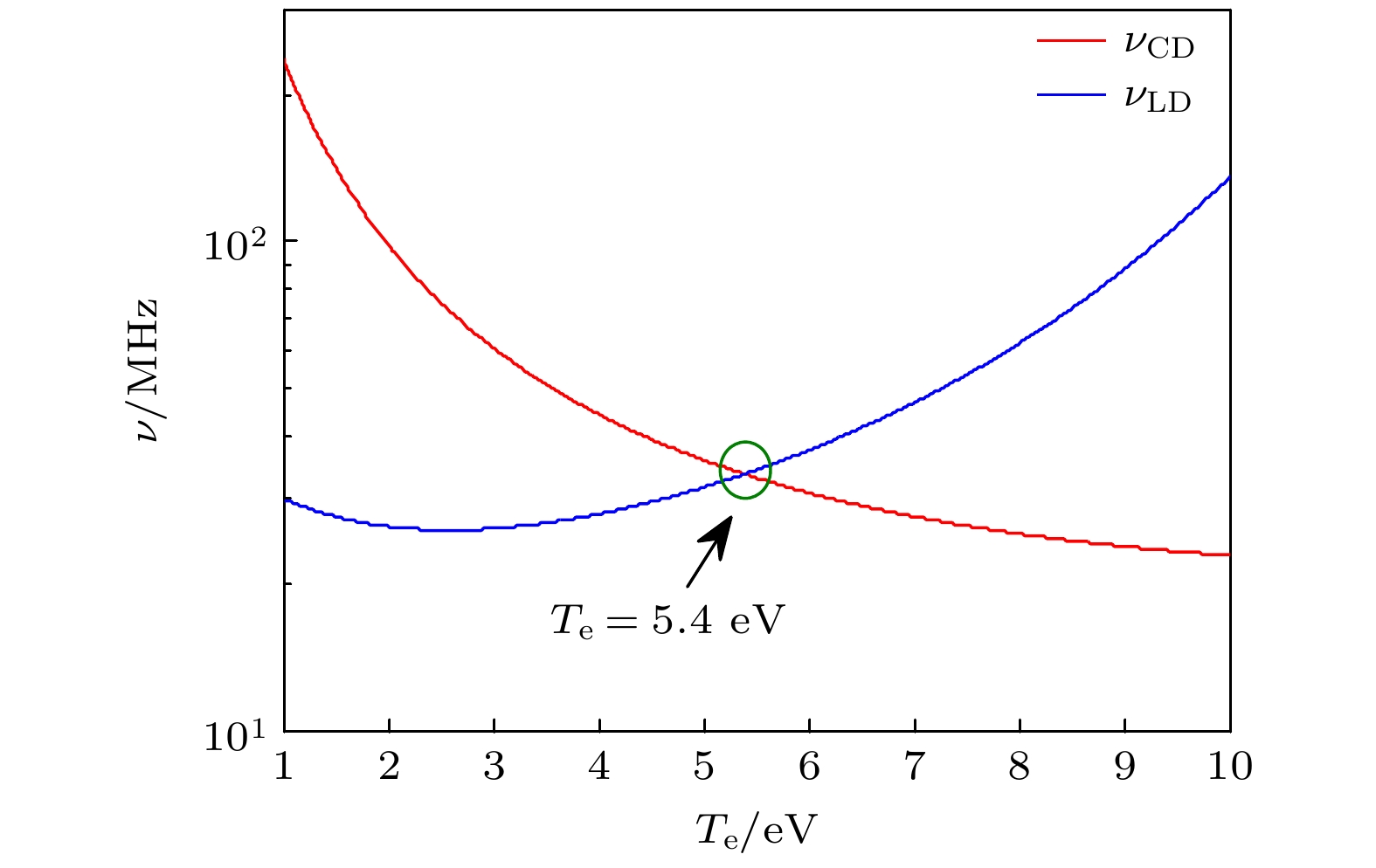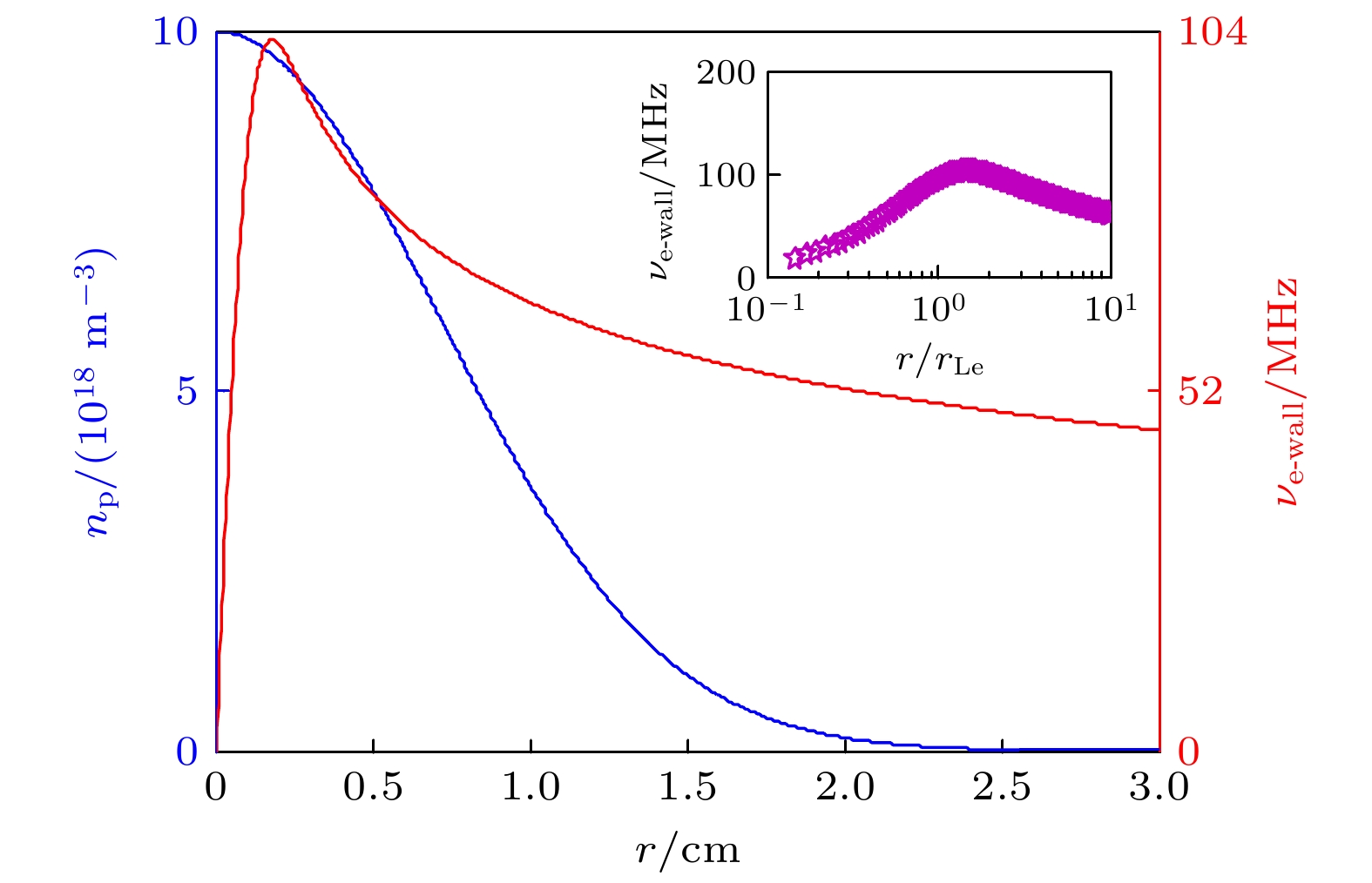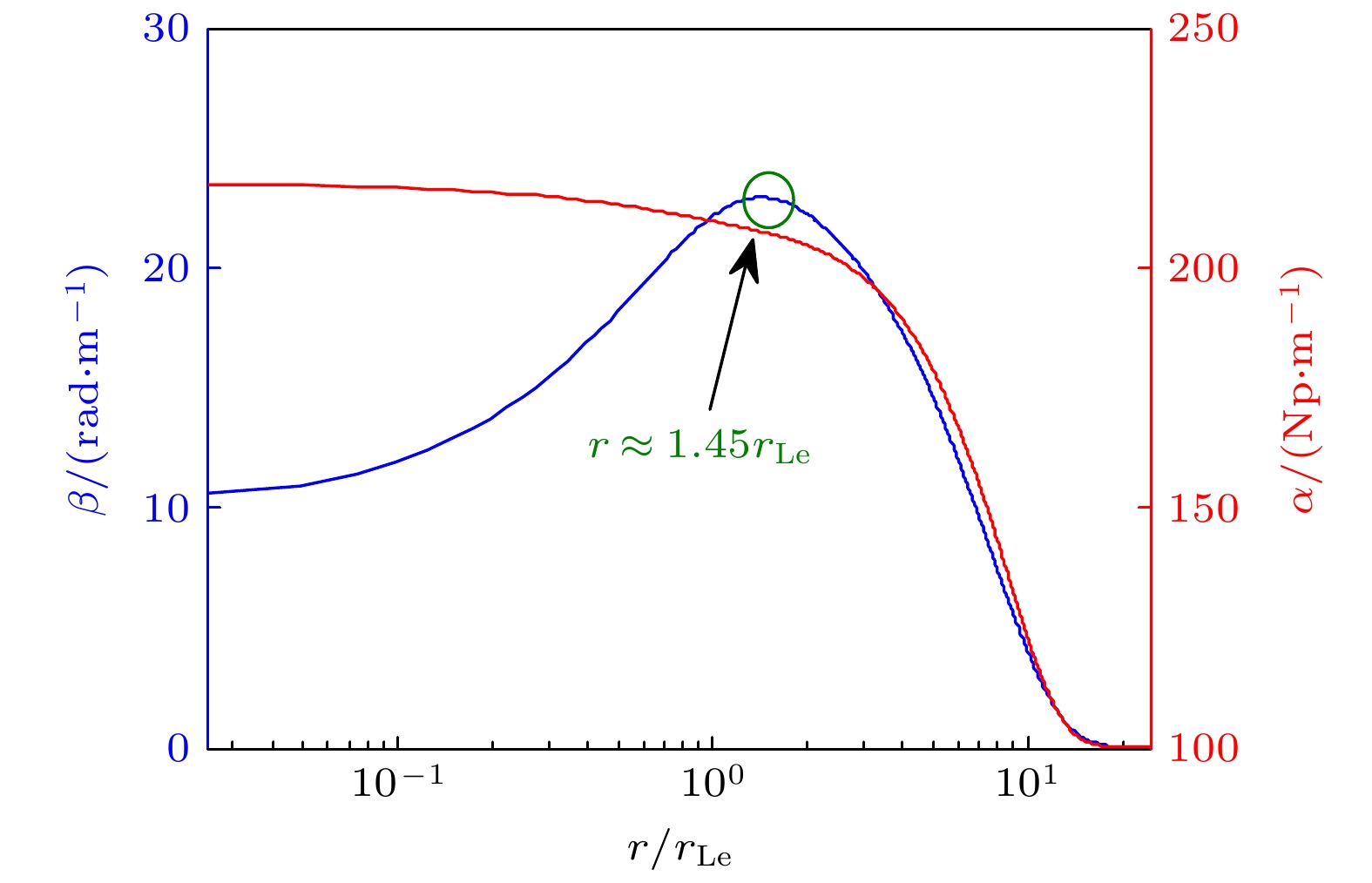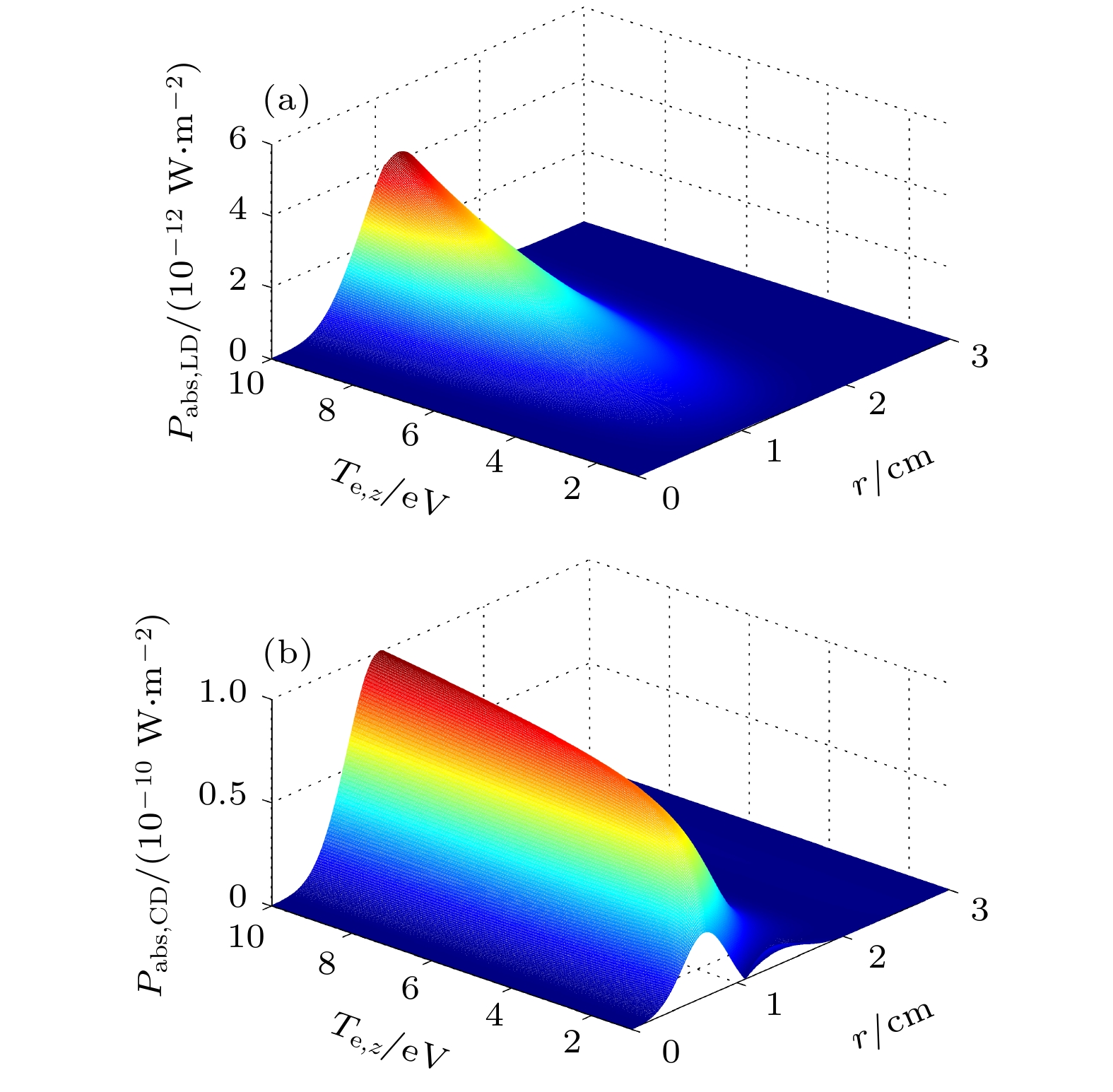-
采用一般的径向密度非均匀分布假设, 借助温等离子体介电张量模型, 利用磁化等离子体中电磁波的一般色散关系, 在高密度峰值、低磁场、低气压典型参量条件下, 重点分析了电子温度各向异性对螺旋波m = 1角向模功率沉积特性的影响. 研究结果表明: 在典型螺旋波等离子体电子温度范围(3, 8) eV内, 电子有限拉莫尔半径效应应当予以考虑, 而离子有限拉莫尔半径效应可以忽略. 低磁场条件下
$|n| > 1 $ 次回旋谐波对介电张量元素的贡献可以忽略. 碰撞阻尼在功率沉积中占据主导地位, 功率沉积在偏离等离子体柱中心轴的某一径向位置出现峰值, 随着轴向电子温度Te, z的增大, 功率沉积强度逐渐增强. 相比等离子体温度各向同性情形, 等离子体温度各向异性显著改变了螺旋波m = 1角向模的功率沉积特性, 电子温度各向异性因子χ = Te,⊥/Te, z的增大或减小均导致功率沉积强度发生剧烈改变.As a core phenomenon in helicon discharge, the plasma temperature anisotropy may play a crucial role in helicon wave power deposition. Under radially inhomogeneous plasma circumstances, by employing the warm plasma dielectric tensor model and considering the finite Larmor radius (FLR) effect and plasma temperature anisotropy effect, under the typical helicon discharge parameter conditions, the helicon wave and Trivelpiece-Gould (TG) wave mode coupling characteristic and influence of electron temperature anisotropy on the helicon wave power deposition induced by collisional and Landau damping mechanism are theoretically investigated. Detailed analysis shows that for typical helicon plasma electron temperature Te = 3 eV and low magnetic field B0 = 48 G, the electron FLR effect should be considered, while the ion FLR effect can be ignored due to its large inertia effect; compared with the$| n | < 2 $ cyclotron harmonics, the contribution of the$| n | > 1 $ harmonics in the calculation of plasma dielectric tensor elements can be ignored due to low magnetic field conditions. For the propagation constant, detailed investigation indicates that the phase constant has a maximum value at a certain radial position, near the same position mode coupling between helicon wave and TG wave happens. Full analysis shows that the power deposition of the m = 1 helicon mode peaks at a certain radial position and increases gradually with the increase of the axial electron temperature. Besides, compared with the Landau damping, the collisional damping plays a dominant role in the power deposition under current parameter conditions; importantly, the electron temperature anisotropy exerts a significant influence on the power deposition characteristic, both the increase and decrease of electron temperature anisotropy factor (χ = Te,⊥/Te,z) can lead the power deposition intensity to change drastically. All these conclusions are very important for us to understand the discharge mechanism of helicon plasma.-
Keywords:
- helicon plasma /
- anisotropy /
- propagation characteristics /
- power deposition
[1] Tynan G R, Burin M J, Holland C, et al. 2004 Plasma Phys. Controlled Fusion 46 A373
 Google Scholar
Google Scholar
[2] Windisch T, Grulke O, Klinger T 2006 Phys. Plasmas 13 122303
 Google Scholar
Google Scholar
[3] Grulke O, Ullrich S, Windisch T, et al. 2007 Plasma Phys. Controlled Fusion 49 B247
 Google Scholar
Google Scholar
[4] Aliev Y M, Krämer M 2011 Phys. Scr. 83 065504
 Google Scholar
Google Scholar
[5] Goyal R, Sharma R P, Scime E E 2015 Phys. Plasmas 22 022101
 Google Scholar
Google Scholar
[6] Marin J F C, Lau C L, Goulding R H, et al. 2021 Plasma Phys. Controlled Fusion 64 025005.
 Google Scholar
Google Scholar
[7] Breizman B N, Arefiev A V 2000 Phys. Rev. Lett. 84 3863.
 Google Scholar
Google Scholar
[8] Chen G, Arefiev A V, Bengtson R D, et al. 2006 Phys. Plasmas 13 123507
 Google Scholar
Google Scholar
[9] Arefiev A V, Breizman B N 2006 Phys. Plasmas 13 062107
 Google Scholar
Google Scholar
[10] Aliev Y M, Krämer M 2008 Phys. Plasmas 15 104502
 Google Scholar
Google Scholar
[11] Aliev Y M, Krämer M 2014 Phys. Plasmas 21 013508
 Google Scholar
Google Scholar
[12] Aliev Y M, Krämer M 2016 Phys. Plasmas 23 103505
 Google Scholar
Google Scholar
[13] Aliev Y M, Krämer M 2023 Phys. Plasmas 30 032102
 Google Scholar
Google Scholar
[14] 成玉国, 程谋森, 王墨戈, 李小康 2014 63 035203
 Google Scholar
Google Scholar
Cheng Y G, Cheng M S, Wang M G, Li X K 2014 Acta Phys. Sin. 63 035203
 Google Scholar
Google Scholar
[15] 赵高, 熊玉卿, 马超, 刘忠伟, 陈强 2014 63 235202
 Google Scholar
Google Scholar
Zhao G, Xiong Y Q, Ma C, Liu Z W, Chen Q 2014 Acta Phys. Sin. 63 235202
 Google Scholar
Google Scholar
[16] Guo X M, Scharer J, Mouzouris Y, et al. 1999 Phys. Plasmas 6 3400
 Google Scholar
Google Scholar
[17] Correyero Plaza S, Navarro J, Ahedo E 2016 52nd AIAA/ SAE/ASEE Joint Propulsion Conference, Salt Lake City, July 25—27, 2016 p5035
[18] Swanson D G 1989 Plasma Waves (New York: Academic Press) p155
[19] Huba J D 2016 NRL Plasma Formulary (Washington: Naval Research Laboratory) p34
[20] Kamenski I V, Borg G G A 1998 Comput. Phys. Commun. 113 10
 Google Scholar
Google Scholar
[21] Mouzouris Y, Scharer J E 1998 Phys. Plasmas 5 4253
 Google Scholar
Google Scholar
[22] Fried B D, Conte S D 2015 The Plasma Dispersion Function: The Hilbert Transform of the Gaussian (New York: Academic Press) p1
[23] Sakawa Y, Kunimatsu H, Kikuchi H, et al. 2003 Phys. Rev. Lett. 90 105001
 Google Scholar
Google Scholar
[24] Shamrai K P, Shinohara S 2001 Phys. Plasmas 8 4659
 Google Scholar
Google Scholar
[25] Loewenhardt P K, Blackwell B D, Boswell R W, et al. 1991 Phys. Rev. Lett. 67 2792
 Google Scholar
Google Scholar
-
图 10 (二维)条件下归一化功率沉积Pabs, CD/max<Pabs, CD>在 (r, χ) 参量空间的分布 (a) ${B_0} = 32{\text{ G}}$; (b) ${B_0} = 40{\text{ G}}$; (c) ${B_0} = 48{\text{ G}}$; (d) ${B_0} = 48{\text{ G}}$
Fig. 10. Distribution of normalized power deposition Pabs, CD/max<Pabs, CD> in the (r, χ) parameter space (two dimensional): (a) ${B_0} = 32{\text{ G}}$; (b) ${B_0} = 40{\text{ G}}$; (c) ${B_0} = 48{\text{ G}}$; (d) ${B_0} = 48{\text{ G}}$.
-
[1] Tynan G R, Burin M J, Holland C, et al. 2004 Plasma Phys. Controlled Fusion 46 A373
 Google Scholar
Google Scholar
[2] Windisch T, Grulke O, Klinger T 2006 Phys. Plasmas 13 122303
 Google Scholar
Google Scholar
[3] Grulke O, Ullrich S, Windisch T, et al. 2007 Plasma Phys. Controlled Fusion 49 B247
 Google Scholar
Google Scholar
[4] Aliev Y M, Krämer M 2011 Phys. Scr. 83 065504
 Google Scholar
Google Scholar
[5] Goyal R, Sharma R P, Scime E E 2015 Phys. Plasmas 22 022101
 Google Scholar
Google Scholar
[6] Marin J F C, Lau C L, Goulding R H, et al. 2021 Plasma Phys. Controlled Fusion 64 025005.
 Google Scholar
Google Scholar
[7] Breizman B N, Arefiev A V 2000 Phys. Rev. Lett. 84 3863.
 Google Scholar
Google Scholar
[8] Chen G, Arefiev A V, Bengtson R D, et al. 2006 Phys. Plasmas 13 123507
 Google Scholar
Google Scholar
[9] Arefiev A V, Breizman B N 2006 Phys. Plasmas 13 062107
 Google Scholar
Google Scholar
[10] Aliev Y M, Krämer M 2008 Phys. Plasmas 15 104502
 Google Scholar
Google Scholar
[11] Aliev Y M, Krämer M 2014 Phys. Plasmas 21 013508
 Google Scholar
Google Scholar
[12] Aliev Y M, Krämer M 2016 Phys. Plasmas 23 103505
 Google Scholar
Google Scholar
[13] Aliev Y M, Krämer M 2023 Phys. Plasmas 30 032102
 Google Scholar
Google Scholar
[14] 成玉国, 程谋森, 王墨戈, 李小康 2014 63 035203
 Google Scholar
Google Scholar
Cheng Y G, Cheng M S, Wang M G, Li X K 2014 Acta Phys. Sin. 63 035203
 Google Scholar
Google Scholar
[15] 赵高, 熊玉卿, 马超, 刘忠伟, 陈强 2014 63 235202
 Google Scholar
Google Scholar
Zhao G, Xiong Y Q, Ma C, Liu Z W, Chen Q 2014 Acta Phys. Sin. 63 235202
 Google Scholar
Google Scholar
[16] Guo X M, Scharer J, Mouzouris Y, et al. 1999 Phys. Plasmas 6 3400
 Google Scholar
Google Scholar
[17] Correyero Plaza S, Navarro J, Ahedo E 2016 52nd AIAA/ SAE/ASEE Joint Propulsion Conference, Salt Lake City, July 25—27, 2016 p5035
[18] Swanson D G 1989 Plasma Waves (New York: Academic Press) p155
[19] Huba J D 2016 NRL Plasma Formulary (Washington: Naval Research Laboratory) p34
[20] Kamenski I V, Borg G G A 1998 Comput. Phys. Commun. 113 10
 Google Scholar
Google Scholar
[21] Mouzouris Y, Scharer J E 1998 Phys. Plasmas 5 4253
 Google Scholar
Google Scholar
[22] Fried B D, Conte S D 2015 The Plasma Dispersion Function: The Hilbert Transform of the Gaussian (New York: Academic Press) p1
[23] Sakawa Y, Kunimatsu H, Kikuchi H, et al. 2003 Phys. Rev. Lett. 90 105001
 Google Scholar
Google Scholar
[24] Shamrai K P, Shinohara S 2001 Phys. Plasmas 8 4659
 Google Scholar
Google Scholar
[25] Loewenhardt P K, Blackwell B D, Boswell R W, et al. 1991 Phys. Rev. Lett. 67 2792
 Google Scholar
Google Scholar
计量
- 文章访问数: 2446
- PDF下载量: 64
- 被引次数: 0

















 下载:
下载:









